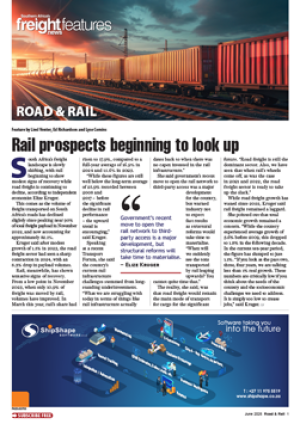In the past few years an extensive
involvement with road freight
into neighbouring member
countries of the Southern African
Customs Union (Sacu) has led
Compu-Clearing to develop a
special system for the job, according
to account manager Gavriel
Rootshtain.
“This targets the BLNS countries
(Botswana, Lesotho, Namibia,
Swaziland) and, in particular, the
Asycuda system that they use,”
he told FTW. “Based on our
experience we have developed a
system specifically designed for the
capturing of customs documentation
for these countries.”
The current BLNS system, he
added, is extremely quick, accurate
and powerful.
He also pointed to various
features which he felt underlined its
versatility.
“These include creating road
manifests; details of all the different
tariff headings which are linked to
our online tariff book that is updated
daily; and a dynamic national
credit limit check, which instantly
suspends the entry if the credit limit
is exceeded.
“The system also creates a unique
UCR number as per the SA Reserve
Bank (SARB) requirements.”
Another of the more recent
developments to the system is a
direct electronic data interchange
(EDI) link with customs - making
the entire process paperless, and
ensuring a quicker, more effective
and accurate practice all round.
Another of the features
highlighted by Rootshtain was the
enquiry screen. “This,” he said,
“shows exactly what is happening
with the user’s shipment, updating
them on how far along the process
is, or why it was rejected. The user
will no longer have to wait for
documentation at the border or have
shipments delayed.”
Amongst Compu-Clearing’s latest
enhancements is a working interface
with the Asycuda system – allowing
the user to directly interface local
data into the Asycuda system.
“This means that, with one click,
the entire entry is now copied into
Asycuda and can be sent to both
sides of the border,” said Rootshtain.
“This interchange of data disposes
of any need for double-capturing or
having to struggle on the Asycuda
system because of slow lines and
down time.”
He saw the entire system as
“a seamless solution” – helping
companies to generate better
communication and manage their
business procedures more efficiently.
And the system development is
an on-going evolutionary process,
Rootshtain added.
“It is only through constant
innovation and development that
we can find ways to make these
processes simpler and rule out
mistakes in the work place.
“This will allow businesses to
retain a healthy relationship with our
neighbours across the border and
continue to build strong economic
growth throughout Africa.”
Electronic clearance system designed for BLNS countries
25 Feb 2010 - by Alan Peat
0 Comments
Cross Border 2010

25 Feb 2010
25 Feb 2010
25 Feb 2010
25 Feb 2010
25 Feb 2010
Border Beat
25 Jun 2025
17 Jun 2025
Poll
Featured Jobs
New
New
